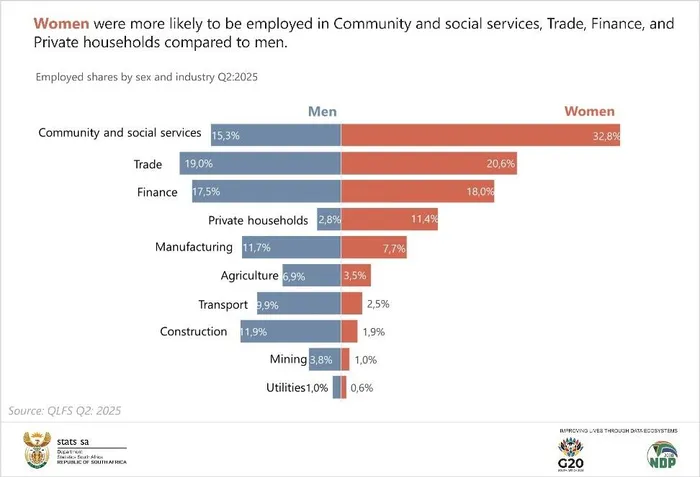
Around 1.2 million women, or 15.9% of those employed, work in the informal sector.
Image: Ron | IOL
Thirty years after the first official National Women’s Day, and 69 years after the historic women’s march to the Union Buildings, women in South Africa continue to face barriers to achieving equal participation in the economy.
From industry concentration and occupational segregation to informal employment and domestic responsibilities, gender gaps persist across the labour market, Statistics South Africa data has found.
This year’s Women’s Month is marked under the theme Building Resilient Economies for All, underscoring the importance of women’s participation in leadership and economic life.
But the latest Quarterly Labour Force Survey (QLFS) for the second quarter of 2025 shows that women remain disproportionately affected by unemployment and economic exclusion, it said.
South Africa’s national unemployment rate is 33.2%, but for women it stands at 35.9%, compared to 31.0% for men – a gap of 4.9 percentage points.
Education has not erased these divides. Among graduates, the unemployment rate is 12.2%, yet female graduates face a rate of 15.0% compared to 8.9% for men, recently released data showed.
Statistics South Africa indicated that the gap is widest among those with only a matric certificate, where women’s unemployment sits at 39.3% versus 31.7% for men. Women without a matric record an unemployment rate of 42.8%, compared to 37.0% for men.
Participation in the labour force also remains unequal. In the second quarter of the year, 65.6% of men of working age were in the labour force, compared to 54.9% of women, data showed.
Although the gap has narrowed slightly over the past decade, millions of women remain excluded from formal economic activity.
Women are clustered in certain industries, with 32.8% employed in community and social services, 20.6% in trade, 18.0% in finance and 11.4% in private households.
They remain underrepresented in sectors such as transport, construction and mining, where representation is just 2.5%, 1.9% and 1.0% respectively.
In the logistics sector, just 25% of women believe salaries are equal, compared to 63% of men, and 45% of women suspect that men are paid more for the same work.
“The disconnect between male and female perceptions of workplace equity is deeply concerning,” says Catherine Larkin, Executive Director of the Chartered Institute of Logistics and Transport South Africa. “If male leaders don't see a problem, it's harder to solve one.”
Occupational patterns reflect similar inequalities according to Statistics South Africa: only 6.8% of women hold managerial roles, compared with 10.7% of men, while many are employed in elementary, sales, service and clerical positions.
For many, the informal sector provides a crucial safety net.

Women are most likely to hold jobs in "softer" careers.
Image: Stats SA
Around 1.2 million women, or 15.9% of those employed, work in the informal sector. The informal employment rate, which includes workers without pensions, medical aid or contracts, stood at 27.2% for women, representing about two million individuals in vulnerable positions.
Domestic responsibilities also weigh heavily on women’s participation.
Of the 2.4 million people who cited “homemaker” as their reason for not being in the labour force, 2.1 million – or 88.2% – were women, compared to 280,000 men.
Despite progress since the march on Pretoria and the declaration of National Women’s Day, the data shows that South Africa’s women continue to bear the greatest share of unemployment, informal work and unpaid care.
